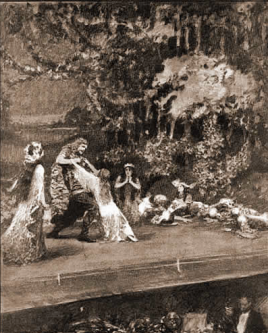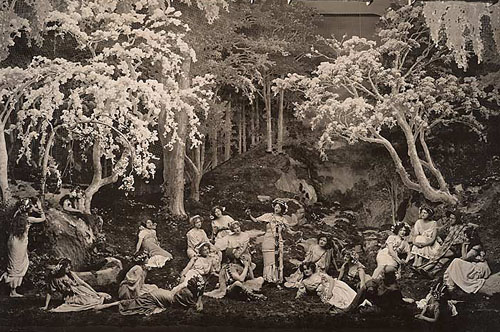 United Kingdom Fallen Fairies: Alan Borthwick and friends, Harrogate G&S Festival, The Harrogate Theatre, Harrogate, 12.8.2014. (RJW)
United Kingdom Fallen Fairies: Alan Borthwick and friends, Harrogate G&S Festival, The Harrogate Theatre, Harrogate, 12.8.2014. (RJW)


Fallen Fairies An Original Comic Opera (1909)
Written by W.S. Gilbert (abridged version by Alan Borthwick)
Composed by Edward German
Fairies:
The Fairy Ethais: Chris Cotter
The Fairy Phyllon: Geoff Lee
Selene (Fairy Queen): Fiona Main
Dartne: Gillian Robertson
Zayda: Susanne Horsburgh
Locrine: Liz Landsman
Lutin ((a serving fairy): Ian Lawson
Mortals:
Sir Ethais: (a Hunnish Knight): Chris Cotter
Sir Phyllon (a Hunnish Knight) :Geoff Lee
Lutin (Sir Ethais’s Henchman): Ian Lawson
Chorus: Katharine Barbour, Maggie Cormack, Wendy Crawford, Lorraine McBain
Director & Producer … Alan Borthwick
Musical Director (at the keyboard) … David Lyle
After the collapse of the G&S partnership Gilbert wrote little operatic material. One of his few collaborators was Edward German who had previously finished Sullivan’s unfinished The Emerald Isle. Fallen Fairies is a reworking of his 1873 play, The Wicked World, which achieved a successful run of 145 performances. In comparison, Fallen Fairies achieved a miserable 50 performances.
So how where has the work stood up to the test of time? With a scene set in Fairyland on the upper side of a cloud which floats over the earth yet is a land of ideal beauty, the content concerns the interaction of personalities and comic comparisons between the worlds of mortals and spirits. There is a summoning of a mortal by the Fairy Queen, very much on the lines of Iolanthe, but in Fallen Fairies her role is taken over by one of her subordinate fairies before being restored to her senior position again. Act II has two particularly good and well sung numbers, Selene’s ‘Thy features are fair’ and Sir Ethais’s ‘When a knight loves ladye’.
In this rare presentation much care has been taken with research to bring authenticity to the costumes: in fact there is a distinct likeness between the character, Lutin and the original creator of the role, C Workman. Appealing property items successfully broke up the monotony of a bare stage and the colourful costumes added to the fine acting. Keyboard accompaniment, however well played, did not really help the audience discover the full quality of German’s score and it is a pity that band parts were not available to allow one to have made a better comparison with Sullivan – or Monckton for that matter. German’s score provided a series of vocal numbers that punctuated the speech and thus brought about a certain monotony of style. Sullivan’s music would often include passages to set mood and accompany entrances appropriate to the character of the actor and German’s comic opera could not be said to step outside the ballad framework of the musical. As the performance developed, one could not help thinking of a likeness to The Arcadians, that successful musical which also opened in 1909 and achieved nearly four times as many performances in its opening run.
Raymond J Walker